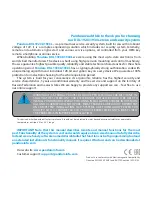
13
9 What To Do In Case Of Fire
10 Troubleshooting
11 Limitation Of Smoke Alarms
Don’t panic; stay calm.
Leave the building as quickly as possible. Touch doors to feel if they are hot before opening them. Use an alternate
exit if necessary. Crawl along the floor, and DO NOT stop to collect anything.
Meet at a pre-arranged meeting place outside the building.
Call the fire department from OUTSIDE the building.
DO NOT GO BACK INSIDE A BURNING BUILDING. Wait for the fire department to arrive.
NOTE: These guidelines will assist you in the event of a fire.However, to reduce the chance that fires will start,
practice fire safety rules and prevent hazardous situations.
Smoke alarms have played a key role in reducing deaths resulting from home fires worldwide. However, like any
warning device, Smoke Alarms can only work if they are properly located, installed, and maintained, and if smoke
reaches the Alarms. They are not foolproof.
Smoke alarms may not waken all individuals.
Practice the escape plan at least twice a year, making sure that everyone is involved – from kids to grandparents.
Allow children to master fire escape planning and practice before holding a fire drill at night when they are sleeping.
If children or others do not readily waken to the sound of the smoke alarm, or if there are infants or family members
with mobility limitations, make sure that someone is assigned to assist them in fire drill and in the event of an
emergency. It is recommended that you hold a fire drill while family members are sleeping in order to determine
their response to the sound of the smoke alarm while sleeping and to determine whether they may need assistance
in the event of an emergency.
Smoke alarms cannot detect fires if the smoke does not reach the alarms.
Smoke from fires in chimneys or walls, on roofs, or on the other side of closed doors may not reach bedroom or
sleeping area-especially if bedroom or sleeping area doors are closed at night- and in the hallway between them.
Smoke alarms may not have time to alarm before the fire itself causes damage, injury, or death, since smoke from
some fires may not reach the unit immediately.
Examples of this include persons smoking in bed, children playing with matches, or fires caused by violent
explosions resulting from escaping gas.
Smoke alarms are not foolproof.
Like any electronic device, smoke alarms are made of components that can wear out or fail at any time. You must
test the unit weekly to ensure your continued protection. Smoke alarms cannot prevent or extinguish fires. They are
not a substitute for property or life insurance.
Smoke alarms have a limited life.
The unit should be replaced immediately if it is not operating properly. You should always replace a smoke alarm
after 10 years from date of purchase. Write the purchase date on the space provided on back of unit.
-
-
-
-
-
Problem
Solution
Red LED flashes and the alarm sounds
one beep every 50 seconds
The Alarm is end. It should replace a new one
Smoke alarm sounds unwanted alarms
intermittently or when residents are
cooking taking showers, etc.
1.Clean smoke alarm. See Section 7 MAINTENANCE AND CLEANING.
2.Hire an electrician to move smoke alarm to a new location.
See section 3 WHERE TO LOCATION
































